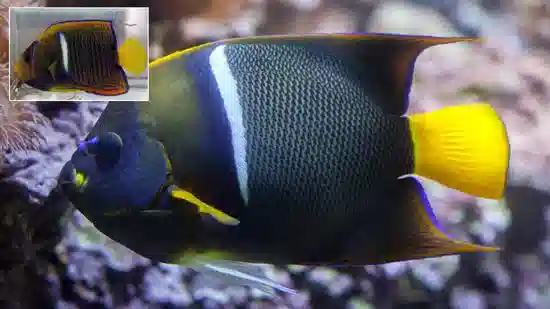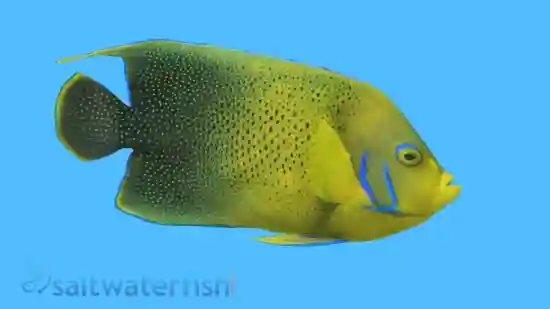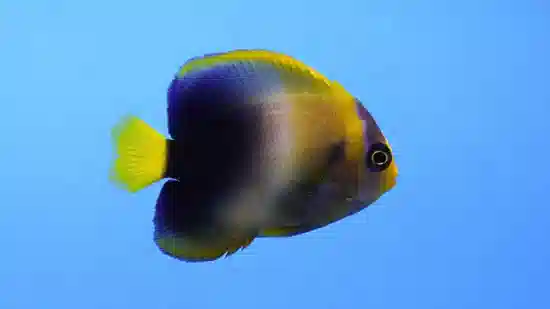French Angelfish
Pomacanthus paru
(1 Reviews)

French Angelfish
Pomacanthus paru
(1 Reviews)
{{ item.name }}
Size: {{ item.extra_field_3 }}
${{ getFormattedPrice(item.saleprice) }} ${{ getFormattedPrice(item.price) }}
To join the waiting list, click here
Free Shipping
With
$199.00
or more in Marine Life.
More details...
French Angelfish Care Facts
| Care Level: | Moderate |
|---|---|
| Temperament: | Semi-Aggressive |
| Diet: | Omnivore |
| Reef Safe: | No |
| Minimum Tank Size: | 120 gallons |
| Max Size: | 15 inches |
French Angelfish (Pomacanthus paru): A Complete Guide
The French Angelfish, scientifically called Pomacanthus paru, is a species that demands attention in saltwater marine aquariums. This no-nonsense guide will provide you with essential information about this species, including its habitat, reef compatibility, size, lifespan, dietary needs in captivity, aquaculture availability, compatibility with other marine inhabitants, sexual dimorphism, coloration changes from juvenile to adult, temperament, tank requirements, and precise water conditions. We'll also explore common names for this species and practical reasons to purchase French Angelfish from Saltwaterfish.com.
Habitat and Natural Range of the French Angelfish
The French Angelfish inhabits the Western Atlantic Ocean, predominantly found along the tropical and subtropical regions from Florida down to Brazil. In its natural habitat, it gravitates toward coral reefs and rocky outcrops, often being spotted in caves or crevices. Understanding its natural environment is crucial for replicating suitable conditions in your aquarium.
Reef Compatibility of the French Angelfish
This species is not considered reef-safe due to its natural inclination to nibble on various sessile invertebrates like sponges and corals.
Size and Lifespan of the French Angelfish
French Angelfish are known for their impressive size, with adults reaching lengths of 15 inches. These fish are no short-term commitment either, boasting a lifespan of up to 15 years or more when provided with proper care.
Diet in Captivity of the French Angelfish
Feeding the French Angelfish in captivity requires a balanced approach. Their diet should include:
- High-Quality Marine Pellets: Incorporate high-quality marine pellets into their daily feeding regimen to ensure they receive essential nutrients.
- Frozen Foods: Supplement their diet with frozen foods like brine shrimp, mysis shrimp, and other marine preparations to provide variety and essential proteins.
- Vegetable Matter: Include marine algae and vegetable matter, such as seaweed sheets, to mimic their natural herbivorous tendencies.
Aquaculture and Availability of the French Angelfish
French Angelfish are occasionally available through aquaculture efforts, although their availability can be limited. To determine current availability, it's advisable to check with trusted suppliers like Saltwaterfish.com.
Compatibility with Other Fish and Invertebrates
The temperament of French Angelfish can vary, but they are generally considered semi-aggressive. Here are five compatible tankmates:
- Tangs and Surgeonfish: Certain tang species like the Yellow Tang (Zebrasoma flavescens) and the Powder Blue Tang (Acanthurus leucosternon) can coexist, especially in larger tanks with ample swimming space.
- Butterflyfish: Peaceful butterflyfish like the Copperband Butterflyfish (Chelmon rostratus) can make suitable tankmates.
- Triggerfish: Larger triggerfish species, such as the Blue Throat Triggerfish (Xanthichthys auromarginatus), can be compatible due to their resilience.
- Groupers: Certain grouper species, like the Panther Grouper (Cromileptes altivelis), can coexist in larger tanks.
Sexual Dimorphism of the French Angelfish
French Angelfish do not exhibit significant sexual dimorphism, making it challenging to distinguish between males and females visually.
Juvenile to Adult Coloration Changes
Juvenile French Angelfish have a striking appearance with vibrant yellow bodies adorned by dark blue vertical bands. As they mature into adults, their colors evolve into an electrifying blend of blue, yellow, and black. Their distinctive beauty makes them a highly sought-after species among marine aquarium enthusiasts.
Temperament of the French Angelfish
The French Angelfish is known for its bold and sometimes territorial temperament. While they can coexist with certain tankmates, providing adequate space and monitoring their interactions is crucial, especially in smaller aquariums.
Tank Requirements for the French Angelfish
To provide the best environment for your French Angelfish, adhere to these tank requirements:
- Minimum Aquarium Size: A tank with a capacity of at least 120 gallons (500 liters) is recommended for a single French Angelfish. Larger tanks are necessary to keep additional angelfish or other tankmates.
- Hiding Spots: Create a habitat with caves, crevices, and ample hiding spots to mimic their natural environment.
- Water Conditions: Maintain stable water parameters, including a pH level between 8.1 and 8.4, salinity ranging from 1.020 to 1.025, a water temperature of 75 to 80°F (24 to 27°C), and suitable water flow.
- Lighting: Provide moderate to high-intensity lighting, as it supports beneficial algae growth and enhances the fish's stunning colors.
Other Common Names for the French Angelfish
The French Angelfish is often called the French Anglerfish, False French Angelfish, or simply French Angel due to its striking appearance.
Why Choose the French Angelfish from Saltwaterfish.com
When considering the purchase of a French Angelfish for your saltwater aquarium, Saltwaterfish.com offers compelling reasons:
- Quality Assurance: Saltwaterfish.com is dedicated to providing healthy and acclimated marine fish, ensuring a solid start for your new addition.
- Expert Guidance: With extensive industry experience, Saltwaterfish.com offers valuable insights and support to help you succeed in caring for your French Angelfish.
- Convenience: Saltwaterfish.com offers a user-friendly online platform for a seamless purchasing experience.
- Ethical Sourcing: By choosing Saltwaterfish.com, you support responsible sourcing practices and marine conservation, contributing to the sustainability of marine ecosystems.
In conclusion, the French Angelfish (Pomacanthus paru) is a captivating and striking addition to your saltwater aquarium. Ensure you provide suitable tank conditions and proper care to enjoy this fish's remarkable beauty and charismatic behavior. Consider this species a valuable addition to your marine setup and explore the possibilities it brings to your aquatic environment.
Very good French Angelfish for your tank. I have lost this species and don't know why. Purchased a new one which just arrived.
Reviewed by: Brian Dogith on Sept. 11, 2021















